2016 was a complicated year for clean technologies, with a decline in investment in clean energy even as deployment of wind and solar grew. These contradictions extend to the battery storage sector, with a recent report by Mercom Capital showing that funding for battery storage companies fell significantly, while project funds boomed.
Total corporate funding for battery storage fell 20% to $540 million. However, while venture capital funding fell only slightly to $365 million, debt and public markets funding fell by nearly half to $175 million. Additionally, no battery storage companies went public during the year.
Generally battery companies focused on storage systems amassed the most funding at $146 million, with lithium-based battery companies receiving only $79 million.
And while corporate funding was slow, funds for deployment were not. During 2016 battery storage project funds ballooned to $820 million, from only $30 million in the previous year.
Popular content
Mercom also reported 11 mergers and acquisitions in the sector, including Total’s acquisition of Saft for $1.1 billion. The report additionally covered developments in the smart grid and efficiency sectors.
It is unclear the relationship between these financial trends and overall activity in the sector. Energy storage deployment has been very uneven from year to year in its largest markets, including the United States.
However, as a promising sign for residential energy storage last week German development bank KfW announced that it would resume payment of subsidies for residential energy storage.
This content is protected by copyright and may not be reused. If you want to cooperate with us and would like to reuse some of our content, please contact: editors@pv-magazine.com.


By submitting this form you agree to pv magazine using your data for the purposes of publishing your comment.
Your personal data will only be disclosed or otherwise transmitted to third parties for the purposes of spam filtering or if this is necessary for technical maintenance of the website. Any other transfer to third parties will not take place unless this is justified on the basis of applicable data protection regulations or if pv magazine is legally obliged to do so.
You may revoke this consent at any time with effect for the future, in which case your personal data will be deleted immediately. Otherwise, your data will be deleted if pv magazine has processed your request or the purpose of data storage is fulfilled.
Further information on data privacy can be found in our Data Protection Policy.